Unlike the gazebo, a typical pergola doesn’t offer any protection from the rain. Common pergolas are usually designed without any overhead covering at all. They provide light shading and act as an extension of outdoor living spaces. Surprisingly, besides providing shelter, one of the main functions of a roof is to help brace the whole structure together, especially against strong winds.

This arrives at the question of ‘How much wind can a pergola withstand’? In this article, we’ll go through how much they can withstand and multiple ways to increase their strength and stability. Let’s dive in, shall we?
How much wind can a pergola withstand?
A few factors contribute to a pergola’s overall ability to stand strong against stormy winds. Namely, it all depends on the type of pergola in the sense of how it was built and how well it was stabilized.
A well structured and braced pergola can withstand winds up to 110 mph (category 3 hurricane). That is, of course, as long as it contains the following to ensure that it has the best chance of standing upright when strong winds are present:
1. Strong base
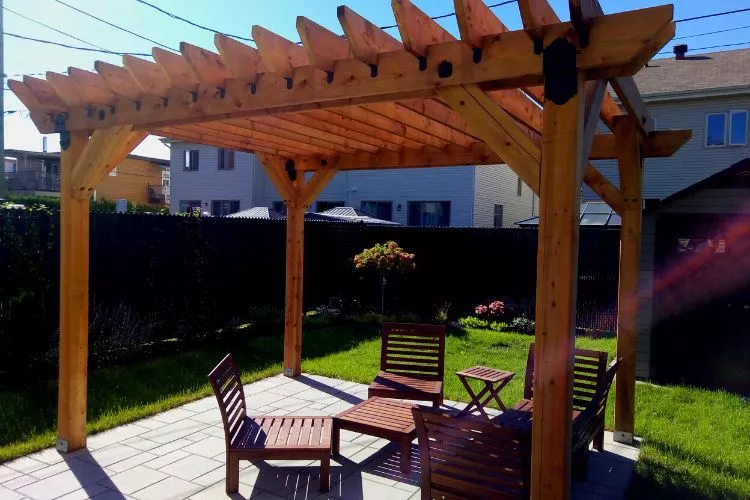
When building any type of structure, such as a house, a garage, an apartment block, etc., the foundation is the first thing that is usually done. The foundation governs any structure’s overall strength and durability.
Having a good quality pergola base includes first assessing the ground to see what the quality is like. Then, digging strategically placed holes for the upright support beams to be fixed. Finally, adding concrete keeps the beams from moving even a millimeter once fixed.
2. Bracing
Once the beams are set, a strong frame can be built and braced so motions such as twisting, dragging, and warping cannot occur. These types of structures can last 30+ years if built properly.
Bracing can involve cross beams as well as joists. Every added piece can support the next and form an immovable structure if done strategically.
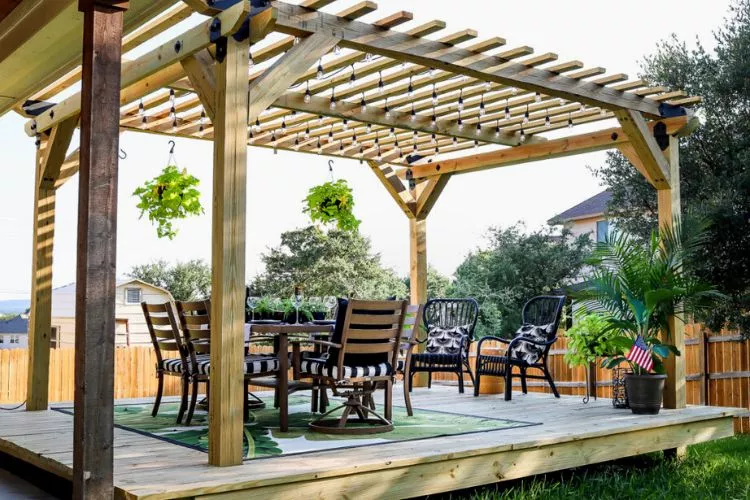
3. Quality materials
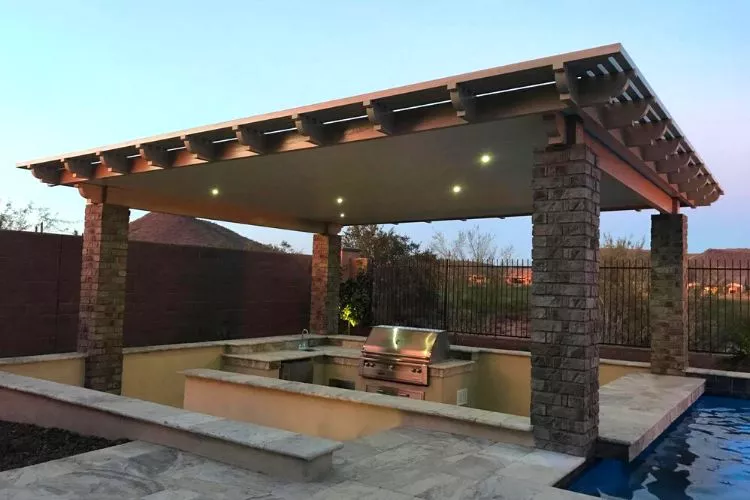
Quite often, we think about price and budget, but when it comes to construction, making something last longer requires good quality materials. These may come at a price, but the long term wear and tear validate that cost.
This includes not only timber, aluminum, copper, or any other framing materials but also tools, screws, nails, bracing plates, etc. Using these will ensure that the whole structure has the strength to hold itself up without any second thought.
How do you stop the wind from destroying a pergola?
As much as we love to have superpowers, it’s quite difficult to control the weather and its potential destruction. If you are using a portable pergola, then the best way to defend against the wind is by adding some extra weight around the support posts and trying to keep them from moving too much.

Otherwise, you can add some support ropes to the corners and find something to tie them off to. Luckily, setting up a pergola in the great outdoors can offer a range of good quality tie off points. Trees, rocks, logs, and bushes can be your best friend. Alternatively, if the wind is becoming dangerous, it’s sometimes better to pack up and go home.
If the pergola is free standing, constructed variant, then you can use a similar method. Add heavy sand/pebble filled bags, gym weights, etc., around the posts. You may add a wind break such as a retaining wall or shade sail.
How can I make my pergola more stable?
If you’re worried about mother nature kicking up strong winds and causing damage to your pergola, then there are a couple of ways to mitigate those risks. Firstly, planning your pergola’s location is essential to its overall stability. Think about erecting or constructing it somewhere that offers some prediction from the wind.
This may include beside a house, retaining wall, or even behind bushes or trees. Anything that can be utilized to dampen the wind’s force can help prevent any damage it may cause. Once the location is set, it’s time to either take some steps towards building it to withstand the wind or strengthen it if it is already built. In this case, one of the following choices will ensure either short or long term stability depending on the amount of effort applied:
Stabilizing a pergola before building
Firstly and possibly the best way to ensure your pergola is secure is by simply building it so it cannot budge. That’s easier said than done, but if a pergola is built with an extremely strong foundation and braced strategically with top quality materials, you’ve already taken some good first steps. This option will ensure that your pergola stands strong for the long term.
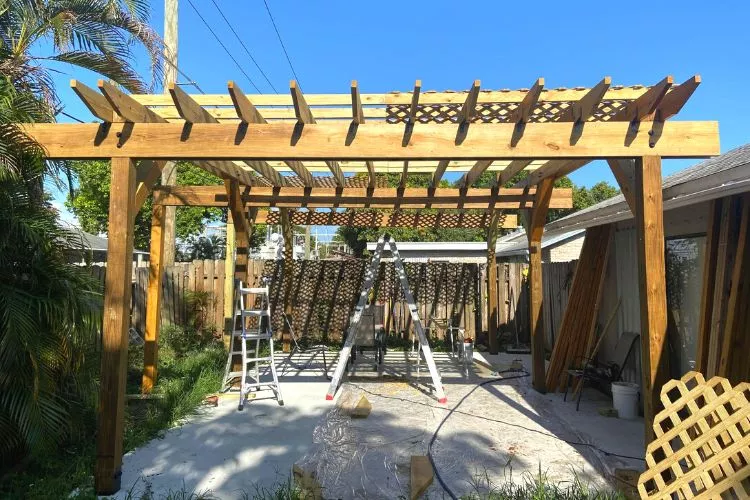
- Plan your build and ensure that each stabilizing beam/post can take an even amount of weight.
- Mark out on the ground where the posts will go.
- Dig a hole for each post that is 1 ft x 1 ft (30 cm x 30 cm) wide and 2 ft (60 cm) deep. Always check on your zones freezing depth and as you may need to go a bit deeper to allow for any concrete cracking. If you’re worried that the ground is slightly soft and may cause stability issues, you can dig down to at least ⅓ of the overall post length.
- For example, if the post is 15 ft (4.5 m) long, it should have at least 5 ft (1.5 m) underground. Keep in mind that we are building for long term stability, so any adjustments should be made accordingly.
- Lower your posts and brace them up, so they are straight both ways (back and forward and side to side). Also, check that they are straight and square with the other posts.
- Fill each hole with concrete, leaving the concrete slightly under (1 inch) the finished ground level to avoid cleaning it away later.
- Trowel off each filled hole, so they are nice and flat.
- Wait 24- 48 hours for the concrete to ‘burn’ and dry.
- Continue building the roof section.
- Make sure to add multiple cross beams for extra support.
Stabilizing an already built pergola
If the pergola is already constructed, a couple of simple adjustments can be made to increase its strength. This can include:

- Adding 1 or multiple diagonal braces: As long as it doesn’t alter the aesthetics, bracing can add great strength, especially diagonally.
- Using a stronger material to reinforce: It is possible to add materials such as steel, aluminum, copper, or even stronger timber alongside the posts to strengthen them further.
- Adding a railing or paneling: You can even construct a waist high, slatted railing to add extra support. This type of bracing looks good as well as pulls the structure together. Timber paneling can also add extra flex power.
- Other: Tensioning is also a great alternative. Some attractive as well as inexpensive high tensile wires are worth doing some research into.
If the overall construction cannot be upgraded, you can also look at some outside stabilization measures. This includes placing weighted objects such as sandbags or specifically designed weights around the support beams. Furthermore, you can use a rope to anchor the pergola down.
The rope can be carefully tied to each corner of the pergola and tethered to something that cannot move, such as a tree, a piece of heavy furniture, some gym weights, some heavy duty tent stakes, etc. Another more expensive option is to add a semi-permanent wind break such as a retaining wall or shade sail. These additions can at least dampen the wind’s power, giving your pergola a bit of respite.
How deep should a pergola post be?
Since pergolas generally don’t have any foundational base, they require their supporting posts/beams to be driven into the ground and supported by concrete. The concrete creates an anchor point which improves the structure’s overall strength. When the concrete is surrounded by undisturbed earth (soil, dirt), it becomes almost immovable.
The optimal depth of the posts should be at least 12 inches (30 cm) below freezing depth. Alternatively, aim to have ⅓ of the post underground. So a 15 ft (4.5 m) post should have at least 5 ft (1.5 m) underground to support it.
Do pergola posts need to be concrete?
Technically, pergolas do not need concrete to reinforce their stability. However, the ground would need to be rock hard without concrete to ensure the pergola wouldn’t move. If the ground is this hard, it would also mean that you would have to struggle to dig into it with absolute precision.
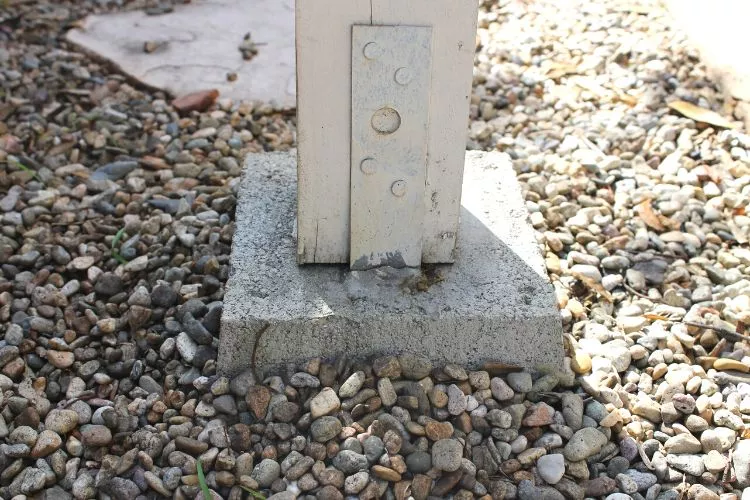
Furthermore, you would have to remove the exact amount of dirt required. Using concrete works best as you can dig without being exact. You can simply fill any extra space with concrete, adding to the overall strength.
You May Also Read: How To Secure A Gazebo From Wind On Concrete
Frequently Asked Questions (FAQs)
Can you put a pergola on pavers?
Pavers can be used as a great base for both portables as well as constructed pergolas. You wouldn’t build a permanent pergola relying on the pavers to keep it stable, but they serve as a great material for foot traffic. When set in place, pavers tend to move around with excessive force if not properly installed. Therefore they cannot be used solely to keep a pergola upright.
Can a pergola rest on a roof?
A pergola can use the roof of a house as an anchor point as long as it is structurally reinforced. Quite often, parts of the roof require dismantling, and extra bracing, beams, fixing supplies, etc., must be added to ensure that the weight of the added pergola doesn’t rip the roof off with excessive winds.
How windy is too windy for a pergola?
Well structured pergolas can handle winds up to 110 mph, which is about the force of a category 3 hurricane. The beauty of pergolas is that they don’t have a roof, meaning they cannot be turned into a kite when the wind picks up. The wind blows through the structure instead. Some well placed windbreaks, such as trees, bushes, shade sails, retaining walls, etc., can help dampen the force. Other structures, such as gazebos and pavilions, can tear to shreds with only small gusts because their roof produces drag.
What is the best shape to withstand wind?
Research has repeatedly proven that hexagonal or octagonal shapes best resist wind. They don’t allow the wind to produce the same drag as a square shape. Furthermore, the roof section’s extra vertices can reflect the wind from all directions. Generally, a multiple-panel roof with four or more panels has the lowest wind loads.
Are 4×4 posts strong enough for a pergola?
4×4 posts are adequate for smaller builds containing only 4-6 posts. They should also have some extra bracing and added windbreaks in the surrounding area to increase the chance of longevity. However, they aren’t as strong at resisting twisting and other environmental wear and tear issues. In this case, choosing a beefier size, such as 6×6, can be much more beneficial.
Conclusion:
The weather is unpredictable so guessing how much wind can a pergola withstand retrieves an answer based on many variables. What type of pergola was built? What materials were used? How strong were its footings? And many more… If all answers point to using strength to build for the pergola’s longevity, then you could be quietly confident to assume that your pergola could survive many storms in the long term. We hope this article has been helpful, and we look forward to seeing you at the next one! Bye for now!


